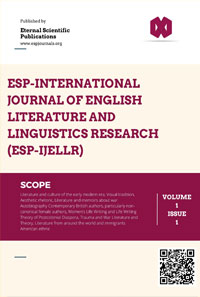ESP International Journal of English Literature and Linguistics Research (ESP-IJELLR)
Citation :
S. Sriram, S. Mahaboob Basha, 2025. "Teaching English Grammar in Indian Schools: Issues, Methods and Innovations" ESP-International Journal of English Literature and Linguistics Research (ESP- IJELLR) Volume 3, Issue 3: 1-9.
Abstract :
The teaching of English grammar in Indian schools, both government and private, has been a matter of serious educational debate for a very long time, which is symptomatic of larger issues concerning pedagogy and second-language acquisition. Although English is a requirement in most Indian school curricula, children often have difficulty becoming fluent in grammar and without fluency it becomes difficult for them to express themselves clearly. Different reasons account for these challenges, including traditional teaching methods, poor teacher training, absence of situational learning and students' cooperation. His approaches have the potential to bring about a transformation of classrooms that, for decades, had been ruled by methods like the Grammar Translation Method (GTM) with its precedence on rote memorization, translation exercises and structural accuracy learning ahead of communicative skills and application in everyday life. These methods ensured that students became acquainted with all of the grammatical rules, but often did not have them apply these rules in speaking and writing situations in real life. Other barriers are high class size, shortage of teaching materials and curricular constraints, as well as low competence regarding contemporary teaching strategies. The two issues above all then combine into the twin perception problems: students lose motivation as they see grammar as a dull and non-practical issue.Since, teaching grammar is not easy Indian schools are adopting several new methodologies and revolution to facilitate its instruction. To develop understanding of grammar in context, emphasis is placed on interaction, purposeful tasks and active student engagement through the Communicative Language Teaching (CLT), Task-Based Language Teaching (TBLT) and Flipped Classroom models. Digital platforms, online play and interactive software provide students with engaging self-paced learning opportunities and technology integration has proven to be a game changer. The grammar rules become easier to memorize and practical application becomes natural with contextual learning, in the form of actual life situations, movies, stories and dialogue! Creative teaching methods such as role-play, storytelling, simulation games and collaboration projects have also proven effective in motivating students to develop their language communication skills. Besides, there are some individual cases from various parts of India indicating innovative interventions which have increased the learning levels in grammar. Projects such as the English training program in Tambaram and Vocabulary Campaign in Ranchi demonstrate how well-organized, teacher-mediated interventions along with a communicative approach kind,have held out promises for positive outcomes on speaking/listening ability. These initiatives demonstrate the importance of shifting curriculum design, using innovative teaching practices and providing teachers with professional development over time.This paper reviews the issues with teaching English grammar in Indian schools, explores traditional and modern approaches to school grammar instruction, and examines new directions that could transform our approach to learning grammar. It aims to provide a solid understanding of recent trends, challenges, and new approaches in grammar instruction through research reports, case studies sharing practical experience from the field. In an effort to provide students with the ability to effectively and confidently utilize English, the study emphasizes the importance of an integrated approach which balances linguistic correctness and practical communication.
References :
[1] Dalal, G., & Gulati, V. (2017). Innovations in English Language Teaching in India: Trends in Language Pedagogy and Technology. Lexington Books.
[2] Hashim, A. A. (2025). Innovative Approaches in English Language Teaching. SAR Publications.
[3] Jain, S. (2025). Problems in Teaching English in Indian Classrooms: Issues and Remedies. ResearchGate.
[4] Suar, G. B. (2025). English Language and Pedagogical Competency of Prospective English Teachers. Frontiers in Education.
[5] Moinuddin, P. (2025). Creativity and Innovation in Language Teaching. RJELAL.
[6] Rochmawati, D. (2019). Innovative Techniques of Teaching English Grammar at Secondary Schools. Journal of English Teaching Adi Buana.
[7] Le, N. T. T. (2021). Learning Grammar in the Context of Writing: A Case Study. VietTESOL Proceedings.
[8] Times of India. (2025, September 15). Tamil Nadu: Special Teachers to Train Kids in Tambaram Corporation Schools in English Grammar, Phonetics.
[9] Times of India. (2025, August 24). District Education Department to Start Vocabulary Campaign in 2.1K Govt Schools.
[10] Times of India. (2025, October 6). Teacher Training Programme Begins at MNNIT Allahabad.
[11] Times of India. (2025, October 4). Moscow University Grant for RMLNLU Professor.
[12] Times of India. (2025, October 8). 95% of Karnataka Schools Adopt New Teaching Methods, but Students Are Still Falling Behind.
[13] GAP Bodhitaru. (n.d.). Methods and Approaches of Teaching English Language in India: An Eclectic Overview.
[14] SCIRP. (2025). Innovations in English Language Teaching in India.
[15] JETIR. (2021). Innovative Techniques and Methods in English Language Teaching.
[16] Varthana. (2023). 5 Best Practices for Teaching English as a Second Language in India.
[17] IIP Series. (2024). New Creative Methods in English Language Teaching.
[18] Innovation in Teaching. (n.d.). Teaching English with Technology.
[19] Varthana. (2024). How to Improve Spoken English in Private Schools in Rural India.
[20] Times of India. (2025, August 24). District Education Department to Start Vocabulary Campaign in 2.1K Govt Schools.
[21] Times of India. (2025, October 6). Teacher Training Programme Begins at MNNIT Allahabad.
[22] Times of India. (2025, October 4). Moscow University Grant for RMLNLU Professor.
[23] Times of India. (2025, October 8). 95% of Karnataka Schools Adopt New Teaching Methods, but Students Are Still Falling Behind.
Keywords :
English Grammar, Second Language Acquisition, Teaching Strategies, Communication Skills, Pedagic Developments, Technology In Education/Student Engagement/Contextual Learning/Teacher Educators And Indian Schools.


 :10.56472/25842773/IJELLR-V3I3P101
:10.56472/25842773/IJELLR-V3I3P101